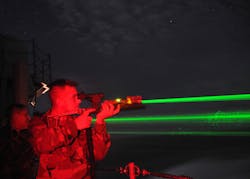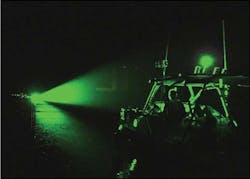PHOTONIC FRONTIERS: NONLETHAL LASERS: Nonlethal lasers deter attacks and warn away noncombatants
Changes in warfare have led the Defense Department to develop a new generation of "nonlethal" weapons, designed and used to warn away noncombatants and temporarily incapacitate adversaries rather than to kill or permanently disable them. They are particularly important in peacekeeping and counter-insurgency operations, where hostile forces can blend into the civilian population, and turning lethal force on civilians can fuel insurgency. The Pentagon's efforts are coordinated by the Joint Non-Lethal Weapons Directorate (JNLWD; Quantico, VA), established in 1997.
Lasers play an important role. US Armed Forces have fielded roughly 30,000 nonlethal lasers, often called dazzlers, which can serve two roles when directed at intruders. A pulsed or steady green beam can warn people a kilometer or more away that they are approaching a sensitive military site. At a few hundred meters, the beam's glare is so intense that the unprotected eye cannot look at it, and it's hard for insurgents to attack a target they cannot see.
Ground troops have deployed dazzlers at checkpoints and on convoys in Iraq and Afghanistan, and naval and commercial ships are deploying them to block attacks by small boats or pirates. "Anecdotal reports suggest that fielded green laser devices have been extremely effective" in engaging intruders and helping warfighters to determine their intent, says Kelley Hughes, spokesperson for JNLWD.
Laser warning and glare
Dazzlers or "optical distractors" are class 3B lasers, with typical powers from 100 to 300 mW. Most military models are mounted on rifles. Beams are pulsed to warn people away from a military site. "A continuous beam may be quite bright, but a pulsed beam gets your attention" because the eye is primed to look for change or motion, says Clint Meyers, nonlethal manager at B.E. Meyers Electro-Optics (Redmond, WA).
The beam from a dazzler diverges more rapidly than that from a laser pointer, as shown in Fig. 1. "All of our lasers produce a big, wide spot so you can keep your target completely enveloped in that glaring beam the whole time," says Meyers. That makes the dazzler easier to aim, ensures that the target notices the illumination, and reduces the laser intensity and the risk of permanent eye damage. Figure 2 shows how the beam from the company's Glare-Mout laser covers a person's head and shoulders at 100 m, and spreads across the front of a vehicle at 500 m.At that range, the laser is so bright that the beam bleaches retinal pigments and causes the pupil to contract, reducing visual response to normal light. The eye also instinctively looks away from the intense beam, as it looks away from the sun, an effect that reduces the chance of eye injury. For minutes after exposure, a bright spot remains in the field of view, fading gradually as the eye recovers. In daytime, the dazzling glare extends to 300 m for a 125 mW laser and to 500 mW for a 200 mW model. At night, that range doubles.
The glare provides "an unequivocal nonverbal warning, and [offers] the target an opportunity to clarify intent," says Hughes. Wayward civilians and would-be attackers who hope to get away can leave. Soldiers suspecting hostile intentions from intruders who continue to face them are armed with dazzler-equipped rifles and are ready to escalate their reaction.
Eye safety and dazzlers
The inner limit of dazzler range is set by the nominal ocular hazard distance (NOHD), where the beam is intense enough to cause eye damage. That distance depends on power, beam divergence, and wavelength. For the B.E. Meyers 125 mW Glare-Mout, the NOHD is 18 m; it increases to 25 m for the 200 mW Glare-Mout Plus. Those dazzlers are sold only to the military, which trains soldiers to watch for people within the NOHD, and to fire the laser only at intruders beyond the NOHD. Intruders approaching closer than that distance are considered likely to be hostile and treated accordingly. Other dazzlers are equipped with laser radars that check that the NOHD is clear. Meyers' 250 mW LA9 dazzler used by the US Navy and Marines includes a laser radar that shuts the beam off if it detects someone within the 41 m NOHD.
Military equipment is exempt from laser safety rules set by the Food and Drug Administration, but dazzlers made for law enforcement, federal agencies, and US-flagged commercial ships require safety interlocks to prevent unsafe eye exposure. B.E. Meyers makes a law-enforcement dazzler called Glare Enforcer, which measures target distance with an eye-safe laser radar and automatically adjusts output power to the highest level that could not cause eye damage.
As with firearms, accidents can happen, and some soldiers have suffered eye injuries. Most eyes heal at least partly, but a few suffer lasting damage. A retired Army medical officer says the worst injury he saw was to an 18-year-old soldier riding in a night convoy in a remote area, who tried to fire a dazzler toward unexpected headlights he saw in the distance. However, the beam hit a rearview mirror only about 6 m away and was reflected back into the soldier's right eye, causing bleeding and permanent damage to the fovea. The victim's vision was impaired, but he was able to remain on active duty.
US and European countries tightly restrict dazzler sales, but lasers with even higher powers are readily available on the Internet and pose serious eye hazards. "Lasers available at Alibaba.com, the Chinese version of eBay, deliver power and beamwidth comparable to [military] dazzlers," says Massimo Annati, a retired Italian rear admiral. "In terms of NOHD they are absolutely more dangerous" than their military counterparts, he says. He cites one model with an NOHD of 130 m—twice that of the most powerful military dazzler—and worries that such lasers could easily fall into the hands of terrorists, protesters, or airplane-illuminating vandals.
Other nonlethal laser systems
Green laser dazzlers are used in the Distributed Sound and Light Array, an audio and optical hailing and warning system being developed by JNLWD. That system also includes searchlights, spotlights, a steerable directional acoustic array, and an infrared (IR) camera. It can "hail, warn, inform, and suppress targeted individuals at distance of up to 2 km, with penetration and voice intelligibility" within vehicles, vessels, and buildings, says Rick Scott, project engineer at JNLWD. The system can be mounted on a tower, vehicle, or ship, and can warn operators of approaching vehicles and vessels on land or at sea.1 A half-size version has been tested successfully in an unmanned surface vessel.
The Non-Lethal Thermal Laser project appears to be a follow-on to the earlier Pulsed Energy Projectile, a controversial program that fired IR pulses to heat the outer layer of the skin, producing a burning pain sensation but not causing lasting injury.2 "The technology topic is conceptual," says Wes Burgei, human effects engineer at JNLWD. The Air Force has tested a system called Active Denial, which uses highly directional 95 GHz microwaves to produce a similar pain effect. Chinese researchers recently reported their own tests of laser-induced pain at a December 2012 SPIE conference in Beijing. They found the pain threshold for 0.1 s pulses from a CO2 laser was 1.0 J/cm2.3
Lasers play a different role in the laser-induced plasma channel,4 a nonlethal system designed to disable vehicles by firing an electric discharge along a laser-ionized path through the air. The Army demonstrated it in 2012 at the Picatinny Arsenal (Picatinny, NJ).
Outlook
Nonlethal lasers offer an important alternative to lethal force when soldiers in difficult environments need to tell the harmless from the hostile. "At checkpoints and on convoys, you never know who is approaching you," says Sjef Orbons of the Netherlands Defense Academy (Breda, the Netherlands). "[Lasers] add an extra step in the escalation sequence before you have to go lethal."The long range of lasers is an advantage that works best for checkpoints, because sites can be chosen to give the clear lines of sight needed to make lasers most effective. Dutch field commanders who had served in Afghanistan considered dazzlers less effective on vehicle convoys, because they move through urban environments without the distance needed for laser warnings. "If someone comes around the corner on a motorbike, you have only seconds to decide [how to react]," Orbons says.5 Lasers likewise work better at night than on bright days when the overhead sun can wash out the beam.
Yet laser warnings can easily be misinterpreted, particularly at long distances. "Green is not a threatening color," and might attract people who thought a flashing green beam might be a signal for help, US Navy tests found.6
The acid test for nonlethal lasers should be how well they work in practice. Anecdotal reports of sharp reductions in checkpoint fatalities are encouraging, but Orbons says hard data are lacking. "If there are no casualties, there is no reporting." Perhaps that's inevitable in the fog of war, but it makes it hard to be sure how well the new technology can ease the tensions that create the hostile atmosphere.
REFERENCES
1. US Department of Defense Non-Lethal Weapons Program, Distributed Sound and Light Array Fact Sheet; http://1.usa.gov/15Ke9TV.
2. D. Hambling, "Maximum pain is aim of new US weapon," New Scientist (Mar. 2, 2005); http://bit.ly/WFIhPK.
3. J.-R. Wang et al., "Cutaneous Pain effects Induced by Nd:YAG and CO2 Laser Stimuli," Proc. SPIE, 8553, 855327 (2012); doi:10.1117/12.2000456.
4. J. Kaneshiro, AMC, US Army web site, "Picatinny engineers set phasers to 'fry,'" (June 21, 2012); http://1.usa.gov/YpBPH3.
5. S. Orbons, Universiteit van Amsterdam dissertation, Non-lethality in reality: a defense technology assessment of its political and military potential (Jan. 30, 2013); http://bit.ly/12LV7Pl.
6. L. Svec, J. Beer, and D. Freeman, Directed Energy in the Military Environment, Leading Edge, 7, 4, 74–77, Naval Surface Warfare Center, Dahlgren Division, Dahlgren, VA (2012).
About the Author
Jeff Hecht
Contributing Editor
Jeff Hecht is a regular contributing editor to Laser Focus World and has been covering the laser industry for 35 years. A prolific book author, Jeff's published works include “Understanding Fiber Optics,” “Understanding Lasers,” “The Laser Guidebook,” and “Beam Weapons: The Next Arms Race.” He also has written books on the histories of lasers and fiber optics, including “City of Light: The Story of Fiber Optics,” and “Beam: The Race to Make the Laser.” Find out more at jeffhecht.com.



